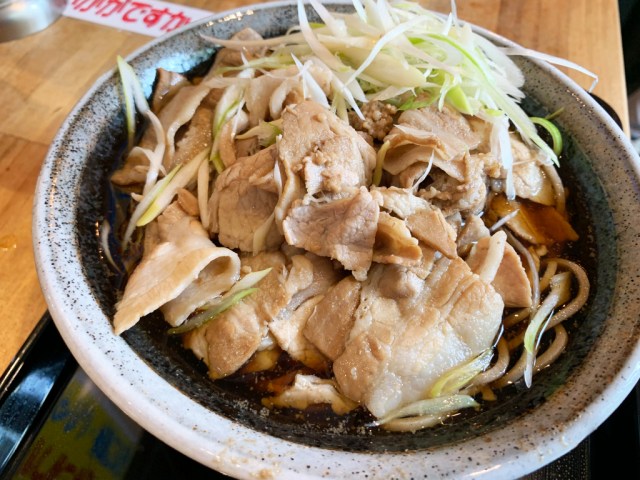
At a time when many small restaurants are going out of business, we speak to the manager of one that took the exact opposite approach.
While some of our staff take joy in tackling gargantuan food challenges, our Japanese-language correspondent Seiji Nakazawa is the resident connoisseur of stand-and-eat (“tachigui”) soba restaurants, having visited just shy 260 of them in Tokyo at this point. A restaurant called Nojiro recently became Seiji’s 269th stand-and-eat soba shop experience, but something special sets this one apart from all of the others he’s visited–the fact that it opened in the middle of a global pandemic when many eateries are suffering a loss of business.
Nojiro is close to Ekoda Station on the Seibu Ikebukuro Line. To get there, leave from the station’s North Exit and walk down a short street lined with shops.
Before long you’ll spy a new-looking wooden building–that’s Nojiro.
The large black banner by the door advertising its name is perhaps more reminiscent of a ramen restaurant than anything else, but underneath the name “stand-and-eat meat soba and meat udon” is clearly noted.
Any noodle dish on the menu could be ordered with either soba or udon noodles as the base. Sample items on the ticket machine include noodles with meat (pork) for 500 yen (US$4.60), plain noodles in broth for 300 yen, noodles with a croquette for 400 yen, and noodles with mixed vegetable and seafood tempura for 460 yen. These are definitely reasonable prices for a stand-and-eat soba shop.
Seiji decided to go for the meat soba and also ordered an extra serving of meat topping for an additional 150 yen. While waiting, he took note of a large bottle of chili oil on the table.
Before long a piping hot bowl of noodles was placed in front of him. He took one look at it…
…and thought to himself, “HOLY COW! Look at all that pork!”
While he had indeed ordered extra meat, he couldn’t even see the noodles underneath it all. Was it a noodle dish with meat, or a meat dish with noodles?
After taking a bite he noted that the pork was delightfully tender and juicy. Its flavor also seeped out into the broth, deepening the flavor and adding a natural sweet and salty edge to it. The broth itself was prepared using a special dashi stock made of frigate tuna, mackerel, and kombu, as he later found out.
He tried adding a little of the chili oil he had spied earlier. It added a tingling spiciness and intensified all of the flavors.
In a way it almost made the soba noodles lose their unique buckwheat taste, so he would probably pass on the oil next time.
The noodles were pleasantly plump. Taking into account the portion size, quality of the meat, and price as well, it was an all-around solid bowl of soba.
At that point Seiji ventured to chat a bit with the manager, Mr. Mitsuda. He was particularly curious to hear more about the opening of the restaurant just a few months ago.
Seiji: “Does Nojiro have any sister restaurants?”
Mr. Mitsuda: “Well, the owner runs a Chinese-style restaurant over in Itabashi [a neighboring district of Tokyo] called ‘Jiro’s Table.’ This is his first stand-and-eat soba restaurant.”
Seiji: “Even if it’s the first, it’s incredibly delicious. Had you ever worked at a soba restaurant before this?”
Mr. Mitsuda: “Thank you. Actually, I perfected this flavor while working at Den Soba in Kodemmacho and Nakajima Shoten in Itabashi.”
Seiji: “Ten Soba, huh–that’s nostalgic [Ten Soba was the 142nd stand-and-eat soba shop that Seiji visited]. On a different note, why did you open this restaurant smack in the middle of the pandemic?”
Mr. Mitsuda: “The owner had always wanted to open a stand-and-eat soba restaurant. As part of our initial research, the two of us went around sampling various similar places, especially the one-man operations. While doing so, we saw several that were absolutely thriving. We thought that this could be a success even at a time like this.”
It sounded to Seiji like they had taken a leap of faith, but also one of confidence, in their undertaking. The place was certainly bustling when he visited at lunchtime and it had already gathered a devoted regular crowd. He attributed its success during the pandemic to a variety of factors including its fast service, relatively hygienic physical setting (no sitting means no unnecessary post-meal lingering, after all), and cheap prices.
Restaurant information
Nojiro / のじろう
Address: Tokyo-to, Nerima-ku, Kotake-cho 1-57-5
東京都練馬区小竹町1-57-5
Open 8 a.m.-7 p.m.
Closed Sundays
All images © SoraNews24
● Want to hear about SoraNews24’s latest articles as soon as they’re published? Follow us on Facebook and Twitter!
[ Read in Japanese ]